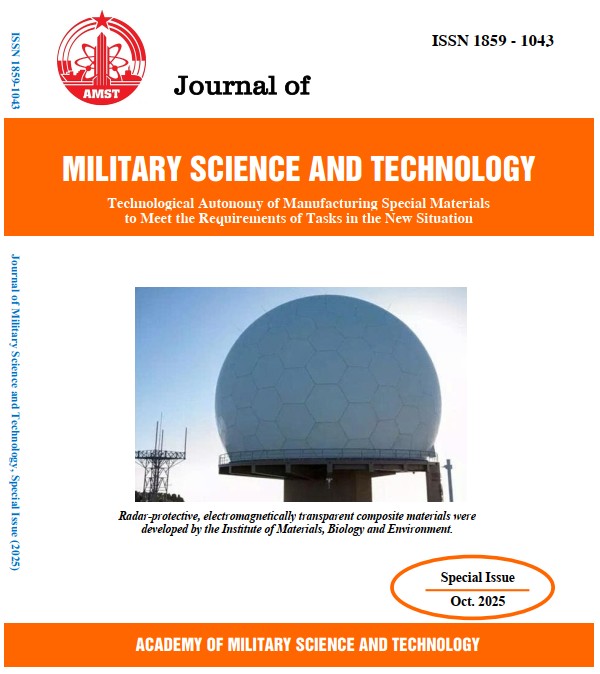Plant-mediated synthesis of sustainable nZVIs anchored on loofah fiber for the degradation of Rhodamine B dye
DOI:
https://doi.org/10.54939/1859-1043.j.mst.IMBE.2025.115-121Keywords:
Zero-valent iron nanoparticles; Loofah sponge; Green synthesis; Cleistocalyx operculatus; Rhodamine B removal; Sustainable materials.Abstract
This study reports a sustainable method for synthesizing zero-valent iron nanoparticles (nZVI) immobilized on loofah sponge (LS) fibers using Cleistocalyx operculatus leaf extract as a green reducing and stabilizing agent. Comprehensive characterization through scanning electron microscopy (SEM), plant digital microscopy (PDM), Fourier-transform infrared spectroscopy (FTIR), confirmed successful nanoparticle formation, uniform dispersion, and effective stabilization. The synthesized composite demonstrated exceptional removal efficiency for Rhodamine B dye, exceeding 97% under optimized conditions. Importantly, the composite maintained robust performance (>65% removal efficiency) across multiple reuse cycles. The integration of biodegradable loofah sponge fibers with bioderived iron nanoparticles offers an innovative, cost-effective, and environmentally friendly approach for dye wastewater remediation, aligning closely with global sustainability and green chemistry objectives.
References
[1]. Glavič, P. “Updated principles of sustainable engineering.” Processes, 10, 870 (2022).
[2]. Pasinszki, T. and Krebsz, M. “Synthesis and application of zero-valent iron nanoparticles in water treatment, environmental remediation, catalysis, and their biological effects.” Nanomaterials, 10 (2020). DOI: 10.3390/nano10050917.
[3]. Fu, F., Dionysiou, D. D., and Liu, H. “The use of zero-valent iron for groundwater remediation and wastewater treatment: A review.” Journal of Hazardous Materials, 267, 194–205 (2014).
[4]. Khadir, A., et al. “The prospective utilization of Luffa fibres as a lignocellulosic bio-material for environmental remediation of aqueous media: A review.” Journal of Environmental Chemical Engineering, 9(1), 104691 (2021).
[5]. Le, N. T., et al. “Green synthesis of highly stable zero-valent iron nanoparticles for organic dye treatment using Cleistocalyx operculatus leaf extract.” Sustainable Chemistry and Pharmacy, 25, 100598 (2022).
[6]. Shen, J., et al. “Mechanical properties of luffa sponge.” Journal of the Mechanical Behavior of Biomedical Materials, 15, 141–152 (2012).
[7]. Popescu, C.-M., Popescu, M.-C., and Vasile, C. “Structural analysis of photodegraded lime wood by means of FT-IR and 2D IR correlation spectroscopy.” International Journal of Biological Macromolecules, 48(4), 667–675 (2011).
[8]. Kheskwani, U. and Ahammed, M. M. “Removal of water pollutants using plant-based nanoscale zero-valent iron: A review.” Water Science and Technology, 88(5), 1207–1231 (2023).







